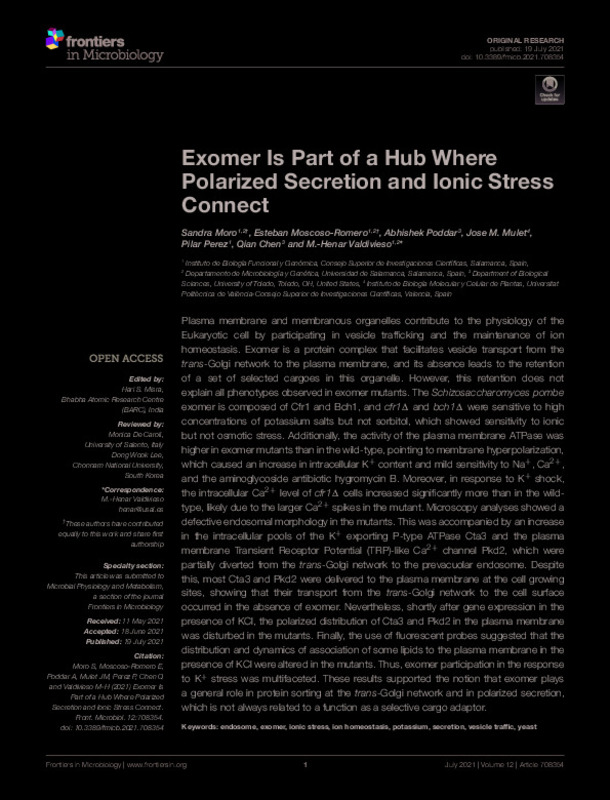|
Resumen:
|
[EN] Plasma membrane and membranous organelles contribute to the physiology of the Eukaryotic cell by participating in vesicle trafficking and the maintenance of ion homeostasis. Exomer is a protein complex that facilitates ...[+]
[EN] Plasma membrane and membranous organelles contribute to the physiology of the Eukaryotic cell by participating in vesicle trafficking and the maintenance of ion homeostasis. Exomer is a protein complex that facilitates vesicle transport from the trans-Golgi network to the plasma membrane, and its absence leads to the retention of a set of selected cargoes in this organelle. However, this retention does not explain all phenotypes observed in exomer mutants. The Schizosaccharomyces pombe exomer is composed of Cfr1 and Bch1, and cfr1¿ and bch1¿ were sensitive to high concentrations of potassium salts but not sorbitol, which showed sensitivity to ionic but not osmotic stress. Additionally, the activity of the plasma membrane ATPase was higher in exomer mutants than in the wild-type, pointing to membrane hyperpolarization, which caused an increase in intracellular K+ content and mild sensitivity to Na+, Ca2+, and the aminoglycoside antibiotic hygromycin B. Moreover, in response to K+ shock, the intracellular Ca2+ level of cfr1¿ cells increased significantly more than in the wild-type, likely due to the larger Ca2+ spikes in the mutant. Microscopy analyses showed a defective endosomal morphology in the mutants. This was accompanied by an increase in the intracellular pools of the K+ exporting P-type ATPase Cta3 and the plasma membrane Transient Receptor Potential (TRP)-like Ca2+ channel Pkd2, which were partially diverted from the trans-Golgi network to the prevacuolar endosome. Despite this, most Cta3 and Pkd2 were delivered to the plasma membrane at the cell growing sites, showing that their transport from the trans-Golgi network to the cell surface occurred in the absence of exomer. Nevertheless, shortly after gene expression in the presence of KCl, the polarized distribution of Cta3 and Pkd2 in the plasma membrane was disturbed in the mutants. Finally, the use of fluorescent probes suggested that the distribution and dynamics of association of some lipids to the plasma membrane in the presence of KCl were altered in the mutants. Thus, exomer participation in the response to K+ stress was multifaceted. These results supported the notion that exomer plays a general role in protein sorting at the trans-Golgi network and in polarized secretion, which is not always related to a function as a selective cargo adaptor.
[-]
|
|
Agradecimientos:
|
Financial support from the Spanish Ministerio de Economía, Industria y Competitividad/European Regional Development Fund¿FEDER¿program (BFU2017-84508-P to M-HV and PGC2018-098924-B-I00 to PP), and from the Junta de Castilla ...[+]
Financial support from the Spanish Ministerio de Economía, Industria y Competitividad/European Regional Development Fund¿FEDER¿program (BFU2017-84508-P to M-HV and PGC2018-098924-B-I00 to PP), and from the Junta de Castilla y Leon/FEDER program (CSI150P20 to PP, and ¿Escalera de Excelencia¿ CLU-2017-03/14-20 to the IBFG), made this work possible. SM was supported by fellowships from the Universidad de Salamanca and the Spanish Ministerio de Educación, and EMR by a fellowship from Junta de Castilla y León. The Agencia Española de Investigación (AEI) Grants PID2019-104054 GB-I00 and RTC-2017-6468-2-AR supported JM. QC and AP were supported by the University of Toledo start up fund and a grant from National Institutes of Health (R15GM134496).
[-]
|









